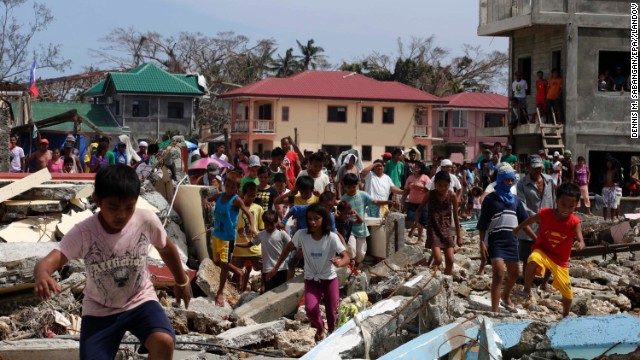
At least 10,000 people are feared to have been killed by Typhoon Haiyan, which struck the central Philippines on Friday.
The UN says more than 11 million people are believed to have been affected by the storm, and some 673,000 displaced.
Several countries have deployed ships to help the relief effort, but bad weather is hampering aid distribution.

The BBC's Jonathan Head, in the badly-hit city of Tacloban on Leyte island, says the main road from the airport to the city is clogged with refugees and debris, and that residents are becoming angry at the lack of progress and increasing breakdown in security.
Valerie Amos, the UN's Under-Secretary-General for Humanitarian Affairs and Emergency Relief, has arrived in Manila to head the aid operation.
She told the BBC the storm had been far worse than expected, and that people in the affected regions were "absolutely desperate".
"They need food, they need water, they need shelter. People need to be protected," she said.
Helicopters were also in urgent need to help with assessing the damage, she said.
Baroness Amos told reporters the UN would work alongside the Philippine government, and that efforts would focus on "food, health, sanitation, shelter, debris removal and also protection of the most vulnerable".
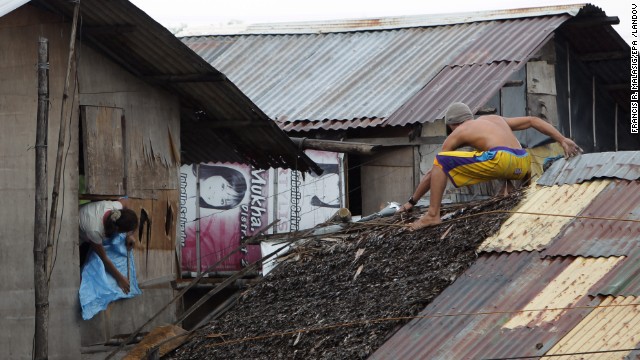
"I very much hope our donors will be generous," she said.
The BBC's Imogen Foulkes, at the UN in Geneva, says the operation will be one of the most challenging the body has ever mounted.
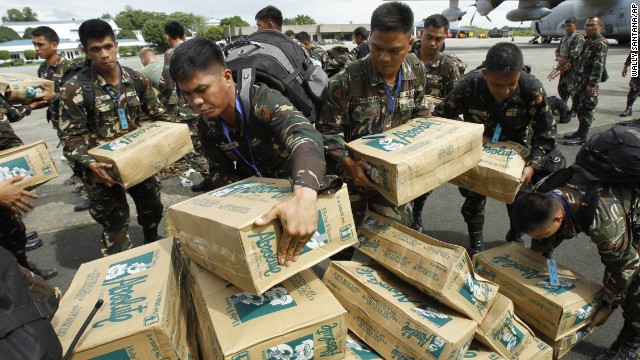
Survivors are scattered across several of the 7,000 islands which make up the Philippines, says our correspondent.
Many areas have not yet been reached, he says - so the figures of those in need, and the estimated death toll of 10,000, could rise.
Security fearsThe UN has already released $25m to address the immediate needs of survivors.
Secretary General Ban Ki-moon described the situation as "heartbreaking".
 Large parts of the Philippines have been devastated by Typhoon Haiyan
Large parts of the Philippines have been devastated by Typhoon Haiyan Thousands of survivors desperately need aid, including food and water
Thousands of survivors desperately need aid, including food and water Some survivors have sought shelter in a convention centre in the ruined city of Tacloban, on Leyte island
Some survivors have sought shelter in a convention centre in the ruined city of Tacloban, on Leyte island Hundreds of people have gathered at Tacloban's destroyed airport, hoping for supplies or the chance to leave the city
Hundreds of people have gathered at Tacloban's destroyed airport, hoping for supplies or the chance to leave the city A handful of survivors were lucky enough to find places on board military flights to Manila
A handful of survivors were lucky enough to find places on board military flights to ManilaA state of national calamity was declared on Monday - a measure designed to speed the supply of aid to the two worst affected provinces, Leyte and Samar.
The National Disaster Risk Reduction and Management Council (NDRRMC) has put the official death toll at 1,774, as of early Tuesday morning, with 2,487 wounded and 82 people listed as missing.
Aid agencies have warned that the security situation is worsening.
Our correspondent said food warehouses and grocery shops had been ransacked, and that people were starting to fear for their safety.
There were also reports that an aid convoy travelling to Tacloban was attacked and two of the assailants shot dead by troops.
Bodies of typhoon victims are lying in the streets or buried under rubble. Some have been buried in mass graves.
The airport at Tacloban - a city with a population of 220,000 - has been severely damaged, meaning aid planes were not able to land for some time.
Large crowds gathered at the airport hoping to be evacuated.
One woman hoping to be flown out said she had had to leave the body of her grandson at a temporary morgue in a hotel. Her son and his wife were also died.
"I asked the mortuary to give my son and his wife proper coffins, but they told me their staff had not reported for work and that some of them were probably dead as well," Maria Adelfa Jomerez told the AFP news agency.
"There are no vehicles to transport them to the cemetery anyway. I would prefer that they not be buried in a mass grave, but I cannot do anything about that."
A spokesman for President Aquino said aid was gradually going in.
"We are not going to leave one person behind, one living person behind," the Associated Press quotes him as saying.
The Philippines air force has been flying C-130 transport planes in and out of Tacloban, carrying relief supplies and evacuating hundreds of residents, a military official told AP.
The US is sending its aircraft carrier USS George Washington and other navy ships to help with the relief work. The carrier is expected to arrive within the next few days. The UK's Royal Navy destroyer HMS Daring is also making its way from Singapore.
Other countries have also pledged millions of dollars in assistance. Japan is providing $10m and Australia $9m in humanitarian aid, while New Zealand has pledged over $1m.
'Like 2004 tsunami'Haiyan - named "Yolanda" by Philippine authorities - struck the coastal provinces of Leyte and Samar on Friday. It was one of the most powerful storms on record to make landfall.
Hundreds of thousands of people were evacuated before the typhoon arrived, but many evacuation centres were unable to withstand the winds and storm surges.
Haiyan brought sustained winds of 235km/h (147mph), with gusts of 275 km/h (170 mph) and waves as high as 15m (45ft).
The typhoon then headed west, sweeping through six central Philippine islands and into Vietnam, where state media said at least 13 people had died.
At least six were also reported killed in southern China, after Haiyan tore through Hainan province and the Guangxi Zhuang autonomous region over the weekend, state media reports.
In the UK, the Disaster Emergency Committee (DEC) group of 14 charities launched its own appeal to help the typhoon victims on Tuesday.
DEC chairman Salah Saeed compared the destruction in the city of Tacloban to that seen after the devastating tsunami of 2004.
"There is currently no food, water or electricity. We can only imagine how much worse the situation will be for families living in towns and remote.
Aid at a glance
AUSTRALIA: $9.3m package, including medical staff, shelter materials, water containers and hygiene kits
JAPAN: $10m, including tents and blankets. 25-person medical team already sent
SOUTH KOREA: $5m plus a 40-strong medical team
INDONESIA: Logistical aid including aircraft, food, generators and medicine
UAE: $10m in humanitarian aid
US: $20m in humanitarian aid, 90 marines, aircraft carrier plus logistics support
UK: $16m (£10m) package including emergency shelter, water and household items
The stories coming out of the Philippines are unimaginable. Rushing water and wind tearing children away from their parents' arms. A death toll that may reach 10,000. A city of 200,000 in which no buildings appear to have survived intact.
One of the most intense typhoons on record, Haiyan (locally known as Yolanda) left catastrophic destruction behind.
If you're looking for someone missing in the Philippines, or if you have information about someone there, Google.org has launched the Typhoon Yolanda Person Finder. A Google crisis map has also been added to detail evacuation centers and areas designated for relief.
Charities and nongovernmental organizations (NGOs) from around the world are responding to this disaster. Many are detailed below with how they're providing aid and how you can help them make a difference.
Emergency support
The Philippine Red Cross (PRC) has deployed rescue and relief teams to evaluate the damage in the areas devastated by Typhoon Haiyan. You can donate to the Philippine Red Cross by selecting theSupertyphoon Yolanda campaign on their donation page. TheInternational Federation of Red Cross and Red Crescent Societies(IFRC) and Red Cross networks from around the world are supporting the Philippine Red Cross. Many have created specific funds for this disaster, including the American Red Cross, Canadian Red Cross and the British Red Cross.
The Salvation Army is on the ground serving storm survivors, primarily with food, water and shelter. Emergency Disaster Service teams have been providing help since the typhoon hit, but are challenged by the lack of accessible roads to transport goods and medical supplies. The non-profit has set up a designated fund for Haiyan relief efforts, which you can access here. You can also make a donation by calling 1-800-SAL-ARMY (1-800-725-2769).
The American Jewish Joint Distribution Committee (JDC) is working with local authorities, the Filipino Jewish community and their global partners to assist in providing for survivors' immediate needs. You can support their efforts online or by phone at 1-212-687-6200.
CARE's emergency response teams are coordinating with local partners in the Philippines to provide food, water, shelter and health care for those in need. Their teams in Vietnam are preparing for the potential need there as Typhoon Haiyan continues its devastation. You can support CARE's efforts on their website, or by phone at 1-800-521-2273 within the United States or +1-404-681-2252 outside the U.S.
Catholic Relief Services, the official international humanitarian agency of the Catholic community in the U.S., is on the ground helping with water purification, shelter materials and essential living supplies. You can donate to the organization's efforts online or you can call 1-877-435-7277. You can also type in your phone number on the website and a representative will call you back to take your donation.
Convoy of Hope's Global Disaster Response Team has shipping containers full of food and supplies on the way to the Philippines. The organization is preparing more supplies to be sent like canned goods, hygiene kits and water filtration units. You can visit Convoy of Hope's website to donate funds to their efforts or call 1-417-823-8998.
Mercy Corps is preparing to deliver food, water, temporary shelter and other basic supplies to devastated areas throughout the Philippines. You can support the organization by donating through their website, PayPal, or by calling 1-888-747-7440.
Oxfam America aid teams are on the ground in northern Cebu, northern and eastern Samar and Leyte, in the Eastern Visayas region in the Philippines. They're working to provide immediate access to water and sanitation materials. You can support this effort by donating online to their Typhoon Haiyan Relief and Recovery Fund, or by phone at 1-800-776-9326.
Adventist Development and Relief Agency's (ADRA) emergency response team is working in Manila and in the province of Bohol to provide food, emergency relief and medical aid to those in need. They have launched an emergency appeal that you can supportonline or by phone at 1-800-424-2372.
The International Rescue Committee (IRC) has dispatched an emergency team to Manila and launched a $10 million appeal in order to ensure immediate needs like safe water, hygiene and sanitation are met. If you would like to contribute to their efforts, clickhere.
Operation Blessing International (OBI) has deployed disaster relief teams in multiple locations following the massive devastation from Typhoon Haiyan. The organization is providing clean water and food, emergency shelter materials and medical assistance. To help the charity's mission, you can make a contribution on their website.
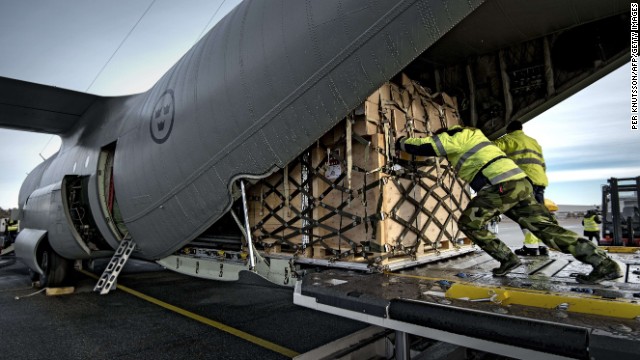
Food and water
The World Food Programme was already providing emergency food assistance in the Philippines following the October earthquake. With these emergency food stocks stretched thin, they're now mobilizing additional supplies and are flying in 40 tons of fortified biscuits in the coming days. Additional food supplies are needed. You can help these efforts by donating online or by calling 1-202-747-0722 domestically or +39-06-65131 for international calls.
Samaritan's Purse has sent disaster relief specialists, including water and nutrition experts, to the Philippines to deliver immediate aid. They have launched the Philippines Emergency Relief fund for this disaster, which you can support online or by phone at 1-828-262-1980.
World Vision is responding in the Philippines by first providing emergency food and clean water. They will also work to create child-friendly spaces and help families rebuild from this disaster. They have launched a Philippines Disaster Response Fund that you can support online or by calling 1-888-511-6443.
Action Against Hunger is on the ground providing drinking water and survival kits containing buckets, soap and chlorine tablets. They're also working to distribute sanitation equipment to prevent outbreaks of waterborne diseases. They're requesting assistance and you can help by donating online or by calling 1-877-777-1420.
Shelter
ShelterBox was already in the Philippines providing shelter after the 7.2 earthquake that hit Bohol on October 15. They are now expanding their operations to provide tents and essential equipment for families left homeless after Typhoon Haiyan. You can support their work in the Philippines either online or by calling 1-941-907-6036.
Habitat for Humanity is already providing help to 30,000 families with shelter repair kits to rebuild their damaged homes. You can support this work by donating from the Philippines to their Re-Build Philippines Fund or from the U.S. by contributing to their Disaster Response Fund. You can also make a donation by phone at 1-800-HABITAT.
Architecture for Humanity is mobilizing to assist with post-disaster reconstruction and the organization's working with local architects to identify the most critical rebuilding needs. You can support their Super Typhoon Haiyan Response online, by calling 1-415-963-3511 or by texting REBUILD to 85944 to make a $10 donation from your mobile phone.

Medical assistance
Americares has an emergency shipment on the way to the Philippines with enough medical aid for 20,000 survivors, including antibiotics, wound care supplies and pain relievers. You can support Americares with an online donation or by calling 1-800-486-4357.
International Medical Corps has pre-positioned medical supplies and their team is on the ground coordinating with their partners in the Philippines to distribute and provide medical aid. You can support their Typhoon Haiyan Emergency Response fund online or by calling 1-800-481-4462.
More than 1.5 tons of emergency medicine and medical supplies are en route to the Philippines from Direct Relief. The supplies include antibiotics, pain relievers, nutritional supplements, antifungal medications, wound dressings and chronic disease medicines. You can call in your donation by dialing 1-805-964-4767 or you can goonline to support the organization.
Médecins Sans Frontières/Doctors without Borders (MSF) have emergency teams in Cebu city with an additional 50 people including medical personnel, logisticians and psychologists arriving in the Philippines in the next few days. They'll bring tents, supplies of drugs, medical equipment and material to purify water, as well as essential plastic sheeting, cooking items and hygiene kits. Teams will monitor possible outbreaks of infectious diseases. An additional cargo is being prepared due to leave later this week from Bordeaux with an inflatable hospital and medical material. You can make your donation by calling 1-212- 763-5779 or online.
Helping children
The U.S. Fund for UNICEF is helping children and their families in the Philippines receive shelter, clean water, nutrition and vaccines. Their emergency response can be supported online or by calling 1-800-367-5437. You can also donate directly to UNICEF in the Philippines here.
Save the Children is offering disaster relief support for children in the Philippines, Laos and Vietnam after Typhoon Haiyan. The charity has pre-positioned relief material kits for children and families, which will include toiletries, household cleaning items, temporary school tents and learning materials. You can support their Philippines Annual Monsoon and Typhoon Children in Emergency Fund online. You can also donate by phone at 1-800-728-3843.
Emergency response teams from ChildFund Internationalprepositioned supplies, including emergency kits and tents, and made arrangements with local suppliers to access food and non-food relief supplies. The organization is also preparing to setup child- centered spaces where kids can feel safe. Donate to ChildFund online to help children cope and recover confidence after this disaster.
Teams from Plan are also on the ground responding to the needs of children and their families. Their priorities are vulnerable youngsters and communities in rural locations. You can support their appeal on their website.
Source: BBC






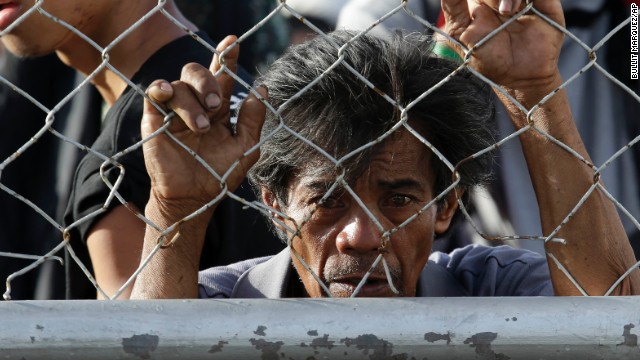


0 comments:
Post a Comment